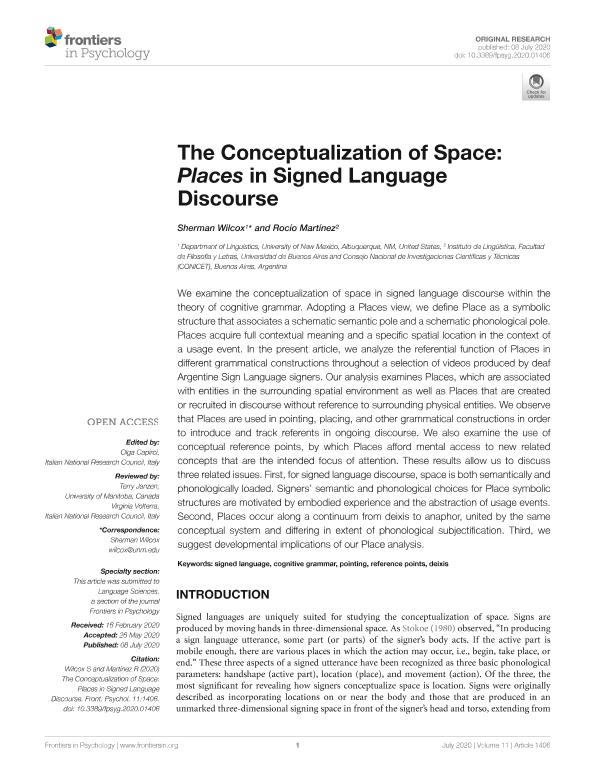Mostrar el registro sencillo del ítem
dc.contributor.author
Wilcox, Sherman
dc.contributor.author
Martínez, Rocío Anabel

dc.date.available
2022-09-19T17:18:37Z
dc.date.issued
2020-07
dc.identifier.citation
Wilcox, Sherman; Martínez, Rocío Anabel; The conceptualization of Space: Places in Signed Language Discourse; Frontiers Media; Frontiers in Psychology; 11; 7-2020; 1-16
dc.identifier.issn
1664-1078
dc.identifier.uri
http://hdl.handle.net/11336/169342
dc.description.abstract
We examine the conceptualization of space in signed language discourse within the theory of Cognitive Grammar. Adopting a Places view, we define Place as a symbolic structure that associates a schematic semantic pole and a schematic phonological pole. Places acquire full contextual meaning and a specific spatial location in the context of a usage event.In the present article, we analyze the referential function of Places in different grammatical constructions throughout a selection of videos produced by deaf Argentine Sign Language signers. Our analysis examines Places which are associated with entities in the surrounding spatial environment, as well as Places that are created or recruited in discourse without reference to surrounding physical entities. We observe that Places are used in pointing, placing, and other grammatical constructions in order to introduce and track referents in ongoing discourse. We also examine the use of conceptual reference points, by which Places afford mental access to new related concepts that are the intended focus of attention.These results allow us to discuss three related issues. First, for signed language discourse, space is both semantically and phonologically loaded. Signers? semantic and phonological choices for Place symbolic structures are motivated by embodied experience and the abstraction of usage events. Second, Places occur along a continuum from deixis to anaphor, united by the same conceptual system and differing in extent of phonological subjectification. Third, we suggest developmental implications of our Place analysis.
dc.format
application/pdf
dc.language.iso
eng
dc.publisher
Frontiers Media

dc.rights
info:eu-repo/semantics/openAccess
dc.rights.uri
https://creativecommons.org/licenses/by/2.5/ar/
dc.subject
SIGNED LANGUAGE
dc.subject
COGNITIVE GRAMMAR
dc.subject
POINTING
dc.subject
REFERENCE POINTS
dc.subject
DEIXIS
dc.subject.classification
Lingüística

dc.subject.classification
Lengua y Literatura

dc.subject.classification
HUMANIDADES

dc.title
The conceptualization of Space: Places in Signed Language Discourse
dc.type
info:eu-repo/semantics/article
dc.type
info:ar-repo/semantics/artículo
dc.type
info:eu-repo/semantics/publishedVersion
dc.date.updated
2022-09-19T15:09:16Z
dc.journal.volume
11
dc.journal.pagination
1-16
dc.journal.pais
Bélgica

dc.journal.ciudad
Brussels
dc.description.fil
Fil: Wilcox, Sherman. University of New Mexico; Estados Unidos
dc.description.fil
Fil: Martínez, Rocío Anabel. Universidad de Buenos Aires. Facultad de Filosofía y Letras. Instituto de Lingüística; Argentina. Consejo Nacional de Investigaciones Científicas y Técnicas; Argentina
dc.journal.title
Frontiers in Psychology
dc.relation.alternativeid
info:eu-repo/semantics/altIdentifier/url/https://www.frontiersin.org/articles/10.3389/fpsyg.2020.01406/full?&utm_source=Email_to_authors_&utm_medium=Email&utm_content=T1_11.5e1_author&utm_campaign=Email_publication&field=&journalName=Frontiers_in_Psychology&id=535539
dc.relation.alternativeid
info:eu-repo/semantics/altIdentifier/doi/https://doi.org/10.3389/fpsyg.2020.01406
Archivos asociados
